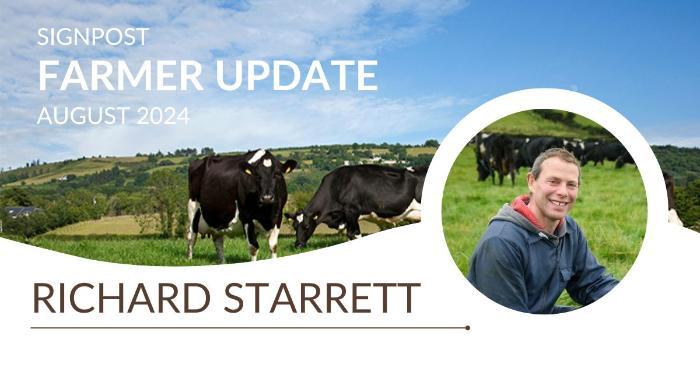Richard Starrett – August 2024

Upgrading housing, equipment maintenance, and fodder planning can ensure optimal herd conditions year-round
Cow comfort is very important on farm in getting ready for winter
Over the past few weeks, we have taken on the job of preparing the yard for next winter.
All animal housing has been power-washed and disinfected. Power-washing the sheds and handling facilities gives a great chance to spot any cracks or strains on gates or barriers. These are usually a quick fix, but it’s a lot easier do this while animals are still out on grass rather than when the sheds are full.
Even small things like having gate latches lined up on dividing gates make life easier for the winter. Water troughs have been checked to make sure there are no leaks; the last thing we want is a water trough leaking into a tank.
We have had cow mats on the cubicles for many years, but unfortunately, there is no quick fix when it comes to these. We had individual mats on the cubicles and they had worked well, but in recent years, they have become worn and milk was beginning to puddle on the mats.
Where milk is puddling and mats are not getting a chance to dry fully, they can pose a risk especially when it comes to somatic cell count. This time last year, we replaced half of the individual cow mats with a continuous roll of rubber on the cubicles.
What we noticed last winter was that cows preferred the newly-installed rubber mats. Where cows are selective in picking cubicles, this can increase the risk of lameness.
Lameness can have a negative effect on milk yield, longevity and fertility, all of which affect the carbon footprint of milk. Cow comfort is of utmost importance here on the farm and the cows clearly showed they were happier on the new mats.
With this in mind, the remaining mats were replaced last week. We are hopeful for good grazing conditions for the remainder of the year, but at least we know that when cows do have to be housed, it’s only a matter of opening the shed door.
We plan to harvest the third cut of silage next week. It’s growing six weeks since the second cut, and over the last week has bulked up nicely.
There are reports that fodder supplies are tight on many farms across the country, but thankfully we will have enough for the winter.
All remaining slurry will be applied to these fields once the silage has been harvested.
This is important in returning the nutrients that have been removed from harvesting, but also we will get more use from the nitrogen in the slurry that was applied in mid-August compared to later in the year.
We have our own equipment to harvest the silage. Once the third cut is complete, we will wash down and grease everything, and take account of any parts that might be required for next year.
Any quiet period over the winter will be used to replace parts and on general maintenance for next year.
